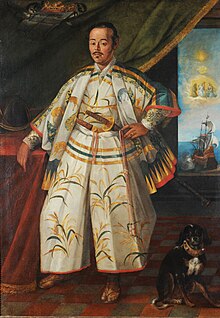Hasekura Tsunenaga
- In this Japanese name, the family name is Hasekura.

Hasekura Tsunenaga (支倉常長, 1571–1622) was a Japanese samurai and diplomat.[1] He was the first diplomat from Japan to visit Spain, France, Italy and the Vatican.
The Roman Senate made Hasekura a citizen and a patrician of Rome.[2]
Early life[change | change source]
Hasekura was a retainer of Date Masamune. Date was the daimyo of Sendai.[3]
Keichō Embassy[change | change source]
Hasekura headed a diplomatic mission from Japan to the Vatican. The trip lasted seven years from 1613-1620,[4] This historic journey is called the "Keichō Embassy" (慶長使節).[5] Hasekura was the first Japanese ambassador in the Americas and in Europe.


Hasekura traveled with a group across the Pacific Ocean to Mexico.[4] They sailed across the Atlantic Ocean to Europe.
Hasekura returned to Japan by crossing Mexico from east to west in 1618. The Japanese sailed from Acapulco for the Philippines. From Manila, they sailed north to Japan in 1620.[4]
The story of Hasekura was unknown in Japan until the 19th century.[6] This early diplomacy not included in official histories written in Japan in the 17th and 18th centuries.[1] Information about this embassy
Hasekura was a subject of interest in Europe. In 1615, Scipione Amati published a book about Haskeura's journey.[7] In 1616, a book about the Japanese diplomats was published in French in Paris.[8]
Legacy[change | change source]
In 1873, Japanese diplomats traveled to Europe. They were surprised to learn about Hasekura. The diplomacy of Hasekura was forgotten because of the Sakoku policy of isolation.[6]
There are statues of Hasekura in Japan,[9] Cuba,[10] Spain,[11] and Italy.[12]
Many people in Coria del Río, Spain have the surname "Japón".[13] These are descendants of the Japanese travelers.[14]
Comet[change | change source]
A minor comet 11514 Tsunenaga was named after Hasekura in 1991.[15]
Memory of the World Programme[change | change source]
Spanish and Japanese archives have documents from the Hasekura mission. The letter carried by Hasekura to the King of Spain is in Seville, Spain. The paper proof of Haskura's Roman citizenship is in Sendai, Japan. These bits of history are proposed for UNESCO's Memory of the World Programme.[16]
Related pages[change | change source]
References[change | change source]
- ↑ 1.0 1.1 Nussbaum, Louis-Frédéric. (2002). "Hasekura Tsunenaga" in Japan Encyclopedia, p. 293.
- ↑ American Historical Association. (1915). The&pg=PA480 Pacific Ocean in Hstory: Papers and Addresses Presented at the Panama-Pacific Historical Congress, held at San Francisco, Berkeley and Palo Alto, California, July 19-23, 1915, p. 480
- ↑ Nussbaum, "Date Masamune," pp. 148-149.
- ↑ 4.0 4.1 4.2 Ministry of Foreign Affairs (MOFA): "Japan-Mexico Relations"; retrieved 2011-11-16.
- ↑ In the name "Keichō Embassy", the noun Keichō refers to the Japanese era name (nengō) after "Bunroku" and before "Genna." In other words, the Keichō Embassy commenced during the years from 1596 through 1615.
- ↑ 6.0 6.1 American Historical Association, p. 480 n1.
- ↑ Amati, Scipione. (1615). Historia del regno di Voxu del Giapone, dell'antichità, nobilità e valore del suo re Idate Masamune, delli favori c'ha fatti alla christianità... e dell'ambasciata che hà inviata alla Sta di N. S. papa Paolo V... fatta per il dottor Scipione Amati (in Italian); retrieved 2011-11-16.
- ↑ Sotello, Louis. (1616). Recit de l'entrée solemnelle et remarquable faicte à Rome, à Dom Philippe François Faxicura, & au Reuerend Pere Frere Louys Sotello ... Ambassadeurs pour Idate Massamune, Roy de Voxu au Iappon. Sur sa Conuersion au Christianisme & recherche de l'alliance des Princes Chrestiens. Vers la Saincteté de N.S.P. Paul v. ... le 25. iour d'Octobre 1615. (in French); retrieved 2011-11-16.
- ↑ Hasekura statue in Ishinomaki, Japan (in Japanese); retrieved 2011-11-16.
- ↑ Hasekura statue in Havana, Cuba Archived 2011-09-29 at the Wayback Machine; retrieved 2011-11-16.
- ↑ Hasekura statue in Coria del Rio, Spain[permanent dead link]; retrieved 2011-11-16.
- ↑ Hasekura statue in Civitavecchia, Italy
- ↑ The surname "Japón" is a shortened form of "Hasekura de Japón".
- ↑ "Spain's Japon clan has reunion to trace its 17th century roots" Archived 2005-04-26 at the Wayback Machine, Japan Times. December 11, 2003; retrieved 2011-11-16.
- ↑ Schmadel, Lutz D. (2003). "11514 Tsunenaga," Dictionary of Minor Planet Names, Vol. 1, p. 763.
- ↑ "Japan, Spain to Seek UNESCO Heritage Ratification," Archived 2011-10-19 at the Wayback Machine Yomiuri Shimbun. October 18, 2011; retrieved 2011-11-17.
Other websites[change | change source]
